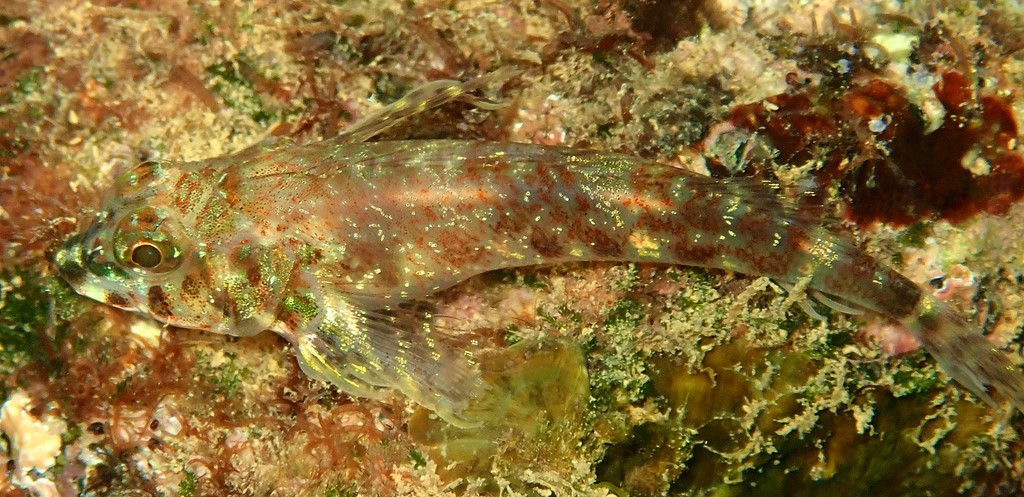HELCOGRAMMA TRIGLOIDES - (BLEEKER, 1858)
Picture courtesy of: Alain Daoulas
Actinopterygii (Gigaclass) > Actinopteri (Class) > Teleostei (Subclass) > Blenniiformes (Order) > Blennioidei (Suborder) > Tripterygiidae (Family) > Tripterygiinae (Subfamily) > Helcogramma (Genus)
Scarf triplefin,
Synonyme
Tripterygion trigloides (Bleeker, 1858)
-------------------------
Description
First dorsal spines (total): 3; Second dorsal spines (total): 13-15; Dorsal soft rays (total): 8-11; Anal spines: 1; Anal soft rays: 16-19. Pectoral fin rays: 16-17; Pelvic fin rays: I, 2. Lateral line continuous, pored scales: 21-29; Head and narrow strip on upper back scaleless, nape with only a few scales. Mandibular sensory pores: 3-8 + 3-9 + 3-8 (usually: 3 + 3 + 3). Supraorbital cirrus small and semi-rounded. Nasal cirrus slender. First dorsal fin lower in height than second. Max. length: 4.5 cm SL. Depth range: 0 - 6 m.
Actinopterygii (Gigaclass) > Actinopteri (Class) > Teleostei (Subclass) > Blenniiformes (Order) > Blennioidei (Suborder) > Tripterygiidae (Family) > Tripterygiinae (Subfamily) > Helcogramma (Genus)
Scarf triplefin,
Synonyme
Tripterygion trigloides (Bleeker, 1858)
-------------------------
Description
First dorsal spines (total): 3; Second dorsal spines (total): 13-15; Dorsal soft rays (total): 8-11; Anal spines: 1; Anal soft rays: 16-19. Pectoral fin rays: 16-17; Pelvic fin rays: I, 2. Lateral line continuous, pored scales: 21-29; Head and narrow strip on upper back scaleless, nape with only a few scales. Mandibular sensory pores: 3-8 + 3-9 + 3-8 (usually: 3 + 3 + 3). Supraorbital cirrus small and semi-rounded. Nasal cirrus slender. First dorsal fin lower in height than second. Max. length: 4.5 cm SL. Depth range: 0 - 6 m.
Color
Males with black mask on lower half of head below eye and a bluish white line extending from corner of mouth onto preopercle. Pectoral-fin base with yellow splotch and bluish white marks; A red blotch on lower base of pectoral fin and bases of ventralmost few rays. All fins dusky to black.
Female overall translucent, head marks brown, H-bars faint, fins translucent.
Etymology
Helcogramma: etymology not explained, perhaps from Greek, helcium = a yoke or collar (harness around the neck of draft animals) + from Greek, gramma = a letter, any writing, a document or record a note of hand, bill, bond, account, written acknowledgement of a debt a letter, an epistle the sacred writings. Possibly referring to lateral line of Helcogramma decurrens, which differs from that of Tripterygion by running “downwards from the shoulder to the middle of the side instead of extending backward parallel with the back”. This unusual lateral line running down the neck may have reminded McCulloch & Waite of that type of equipment, which was still in use when the genus was described.
trigloides: from Greek, Trigla = red mullet from gurnard genus (Scorpaeniformes: Triglidae) + from Greek, –oides = having the form of. Referring to gurnard-like appearance of head, body, and pectoral fins.
Original description: Tripterygion trigloides Bleeker, 1858 - Type locality: Southeastern edge of Harbor, Port Narevin, Erromango Island, Vanuatu, 18°44'25"S, 169°12'41"E, depth 0-6 meters.
Distribution
Western Pacific: East Andaman Sea, Malaysia, Indonesia, Philippines, Taiwan, Papua New Guinea, Solomon Islands, New Caledonia and Vanuatu.
Males with black mask on lower half of head below eye and a bluish white line extending from corner of mouth onto preopercle. Pectoral-fin base with yellow splotch and bluish white marks; A red blotch on lower base of pectoral fin and bases of ventralmost few rays. All fins dusky to black.
Female overall translucent, head marks brown, H-bars faint, fins translucent.
Etymology
Helcogramma: etymology not explained, perhaps from Greek, helcium = a yoke or collar (harness around the neck of draft animals) + from Greek, gramma = a letter, any writing, a document or record a note of hand, bill, bond, account, written acknowledgement of a debt a letter, an epistle the sacred writings. Possibly referring to lateral line of Helcogramma decurrens, which differs from that of Tripterygion by running “downwards from the shoulder to the middle of the side instead of extending backward parallel with the back”. This unusual lateral line running down the neck may have reminded McCulloch & Waite of that type of equipment, which was still in use when the genus was described.
trigloides: from Greek, Trigla = red mullet from gurnard genus (Scorpaeniformes: Triglidae) + from Greek, –oides = having the form of. Referring to gurnard-like appearance of head, body, and pectoral fins.
Original description: Tripterygion trigloides Bleeker, 1858 - Type locality: Southeastern edge of Harbor, Port Narevin, Erromango Island, Vanuatu, 18°44'25"S, 169°12'41"E, depth 0-6 meters.
Distribution
Western Pacific: East Andaman Sea, Malaysia, Indonesia, Philippines, Taiwan, Papua New Guinea, Solomon Islands, New Caledonia and Vanuatu.
Biology
Adults inhabit coral and rocky bottoms. Eggs are hemispherical and covered with numerous sticky threads that anchor them in the algae on the nesting sites. Larvae are planktonic which occur primarily in shallow, nearshore waters
Similar species
Helcogramma fuscopinna (Holleman, 1982) - Reported from East and South Africa, Seychelles, Madagascar and Mascarenes east to Maldives and Chagos Archipelago.
Helcogramma nesion (Williams & Howe, 2003) - Reported from Southern Japan including Ogasawara Islands.
Helcogramma nigra (Williams & Howe, 2003) - Reported from Western Pacific: Papua New Guinea, Solomon Islands and Fiji Islands, Vanuatu and Rotuma Islands.
Helcogramma vulcana (Randall & Clark, 1993) - Reported from Banda Sea, Indonesia.
Adults inhabit coral and rocky bottoms. Eggs are hemispherical and covered with numerous sticky threads that anchor them in the algae on the nesting sites. Larvae are planktonic which occur primarily in shallow, nearshore waters
Similar species
Helcogramma fuscopinna (Holleman, 1982) - Reported from East and South Africa, Seychelles, Madagascar and Mascarenes east to Maldives and Chagos Archipelago.
Helcogramma nesion (Williams & Howe, 2003) - Reported from Southern Japan including Ogasawara Islands.
Helcogramma nigra (Williams & Howe, 2003) - Reported from Western Pacific: Papua New Guinea, Solomon Islands and Fiji Islands, Vanuatu and Rotuma Islands.
Helcogramma vulcana (Randall & Clark, 1993) - Reported from Banda Sea, Indonesia.
Last update: 14, June 2022
